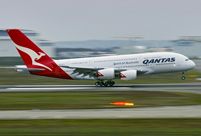 'Model husband' shatters image of love
'Model husband' shatters image of love
 Can animals smile? Or put on a happy face
Can animals smile? Or put on a happy face
 Geng Xuan crowned at 9th China Super Model Contest
Geng Xuan crowned at 9th China Super Model Contest
 Top 10 billionaires in the liquor industry
Top 10 billionaires in the liquor industry
 Backstage at China Fashion Week
Backstage at China Fashion Week
 Ballerinas anywhere but onstage
Ballerinas anywhere but onstage
 Top 10 safest airlines in the world
Top 10 safest airlines in the world
 Posters of 33rd HK Film Awards unveiled
Posters of 33rd HK Film Awards unveiled
 Top 10 most popular instant messaging apps in the world
Top 10 most popular instant messaging apps in the world
 Inspiring shadow images of Chinese army
Inspiring shadow images of Chinese army
THE frustrating monthlong search for a missing Malaysian jetliner received a tremendous boost when a navy ship detected two more signals that most likely emanated from the aircraft’s black boxes. The Australian official coordinating the search expressed hope yesterday that the wreckage will soon be found.
Angus Houston, head of the joint agency coordinating the search in the southern Indian Ocean, said the Australian naval vessel Ocean Shield picked up the two signals on Tuesday, and that an analysis of two sounds detected in the same area last Saturday showed they were consistent with a plane’s black boxes.
“I’m now optimistic that we will find the aircraft, or what is left of the aircraft, in the not-too-distant future. But we haven’t found it yet, because this is a very challenging business,” Houston told reporters.
The signals detected 1,645 kilometers northwest of Perth are the strongest indication yet that the plane crashed and is now lying at the bottom of the ocean in the area where the search is now focused. Still, Houston warned he could not yet conclude searchers had pinpointed MH370’s crash site.
“I think that we’re looking in the right area, but I’m not prepared to say, to confirm, anything until such time as somebody lays eyes on the wreckage,” he said.
Finding the black boxes is a matter of urgency because their locator beacons have a battery life of only about a month, and Tuesday was one month since the plane vanished with 239 people on board.
If the beacons blink off before the black boxes’ location can be determined, finding them in such deep water — about 4,500 meters — would be an immensely difficult, if not impossible, task.
The Ocean Shield first detected underwater sounds last Saturday before losing them, but managed to pick them up again on Tuesday, Houston said. The ship is equipped with a US Navy towed pinger locator designed to detect signals from a plane’s two black boxes — the flight data recorder and cockpit voice recorder.
A data analysis of the signals heard on Saturday determined they were distinct, man-made and pulsed consistently, Houston said, indicating they were from a plane’s black box and consistent with the specification and description of a flight data recorder.
To assist the Ocean Shield, the Australian navy yesterday began using parachutes to drop a series of buoys in a pattern near where the signals were last heard.
Royal Australian Navy Commodore Peter Leavy said each buoy will dangle an underwater listening device called a hydrophone about 300 meters below the surface to help pinpoint the location of the signals.
Houston acknowledged searchers were running out of time, and noted that Tuesday’s signals were weaker and briefer than those at the weekend, suggesting the batteries might be dying.
Picking up the sound again is crucial to narrowing the search area so a small, unmanned submarine can be deployed to create a sonar map of a potential debris field on the ocean floor. The sub, Bluefin 21, takes six times longer to cover the same area as the pinger locator, which is pulled behind the boat at a depth of 3,000 meters.
US Navy Captain Mark Matthews said the detections indicate the device emitting the pings is somewhere within a 20 kilometer radius. Still, he said, that equates to a 1,300 square kilometer chunk of the ocean floor.
That amounts to trying to find a desktop computer in a city the size of Los Angeles and would take the sub about six weeks to two months to canvass.
The disappearance of Malaysia Airlines flight MH370 on a trip from Kuala Lumpur to Beijing on March 8 has sparked one of aviation’s biggest mysteries.
The search has shifted from waters off Vietnam, to the Strait of Malacca and then to waters in the southern Indian Ocean as data from radar and satellites was further analyzed.
 Wonderful moment of China's airborne forces
Wonderful moment of China's airborne forces Bai Baihe shoots for fashion magazine
Bai Baihe shoots for fashion magazine Red terraced fields in Dongchuan of Yunnan
Red terraced fields in Dongchuan of Yunnan Jiaju Tibetan Village
Jiaju Tibetan Village Spring dating
Spring dating Confucius institute at UC Davis
Confucius institute at UC Davis Little painted faces at temple fair
Little painted faces at temple fair Top 10 safest airlines in the world
Top 10 safest airlines in the world Foreign students at China-Myanmar border
Foreign students at China-Myanmar border The backstage of the Fashion Week
The backstage of the Fashion Week College students in Han costumes
College students in Han costumes Postgraduate works as waitress
Postgraduate works as waitress Life in a Lahu village in Yunnan
Life in a Lahu village in Yunnan An orphan’s wedding
An orphan’s wedding Hollywood documentary brings Diaoyu Islands truth to new audience
Hollywood documentary brings Diaoyu Islands truth to new audienceDay|Week|Month